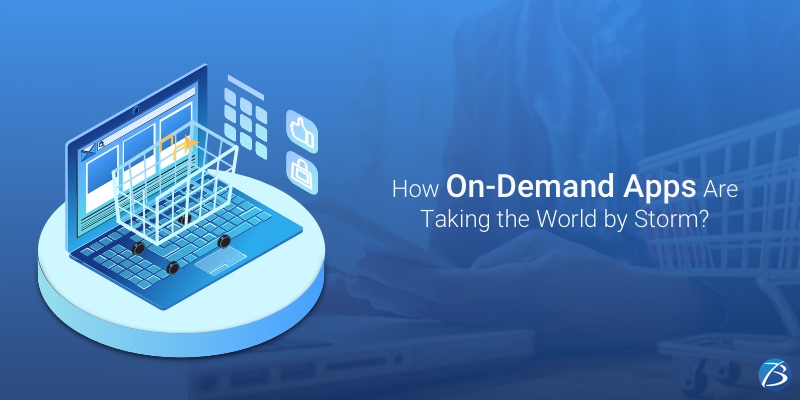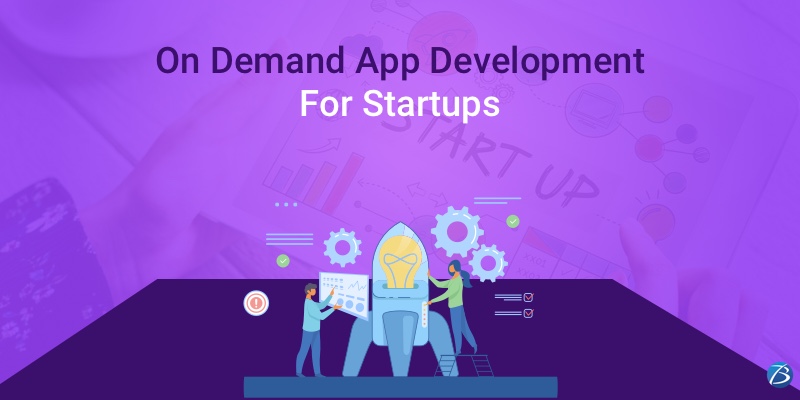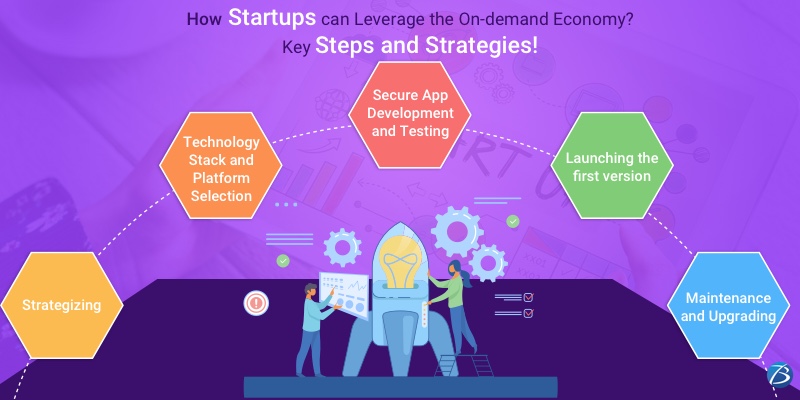Costing of Constructing a Unique On-Demand Music Streaming Application like Spotify!
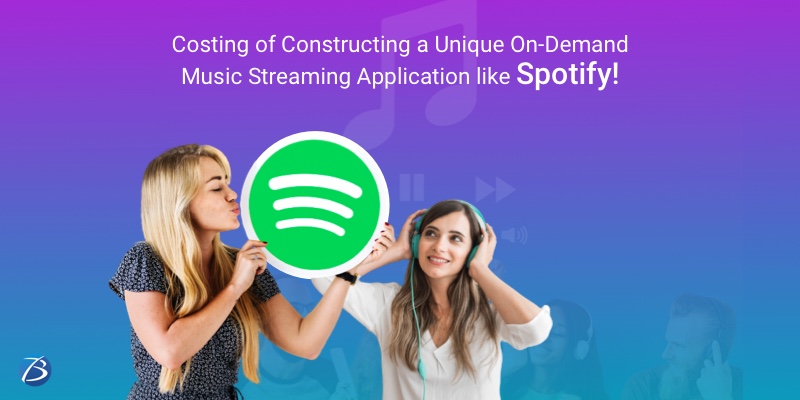

Music is a universal companion for all. And the best thing about it is that in today’s digital era, we can carry music anywhere we go, owing to our smartphones and music streaming apps like Spotify, SoundCloud, Pandora, Google Play Music, iTunes Music, etc.
Technology in music has advanced to such an extent that we can’t even think of playing music using tape recorders, or mp3 players having limited storage of songs. New generations are gradually getting addicted to the ease of accessing hundreds of songs of their choice in an instant through music apps. No wonder why the popularity of such music apps is soaring.
Here are some statistics on the rising number of music streaming users; the source being Statista, a renowned online portal for getting up-to-date statistics.
The number of users of music streaming apps was 1268.5 M in 2018 and grew to 1315 M in 2019. In 2020, this number crossed 1351 M and in 2021, it is expected to cross 1379 M. Furthermore, the estimates depict that by 2022, this number will cross 1400 M users.
These exponentially growing figures support the fact that On-Demand music streaming apps and websites will be in high demand in the coming years.
So, this blog is intended to help On-Demand App Development companies and entrepreneurs who are willing to create such an app. Here we will explain in detail how much does the development of a Spotify-like app costs and what factors affect these cost considerations. But before we delve into the topic, let’s look at what is Spotify and why it became so popular.
What is Spotify and Why it is so Popular?
Spotify is a music and video streaming platform that enables users to easily browse through millions of songs and playlists. Launched in 2008, this Swedish-based app provides any genre of music to anyone across the globe. It allows users to share the songs, create playlists to add favorite tracks, and also collaborate with friends for creating compilations. It comes in paid as well as ‘Spotify free’ versions. In the free version, one can’t download the songs and has to listen or watch frequent ads in between. But the premium accounts have no such restrictions or disturbances.
Spotify has now gone a step further by providing specially-created content of artists, podcasts, etc. to the users apart from series of musical audios and videos. The app makes use of technologies like machine learning, artificial intelligence, etc. for analyzing the listening habits and patterns of the users and providing them customized recommendations based on that.
So, Spotify has all the features of ideal music streaming app i.e. quick access, unlimited storage, affordability, and social engagement; and hence, it has been a top choice of millions of music lovers. The app literally rules the music world.
Factors Affecting the Cost of a Music Streaming App like Spotify
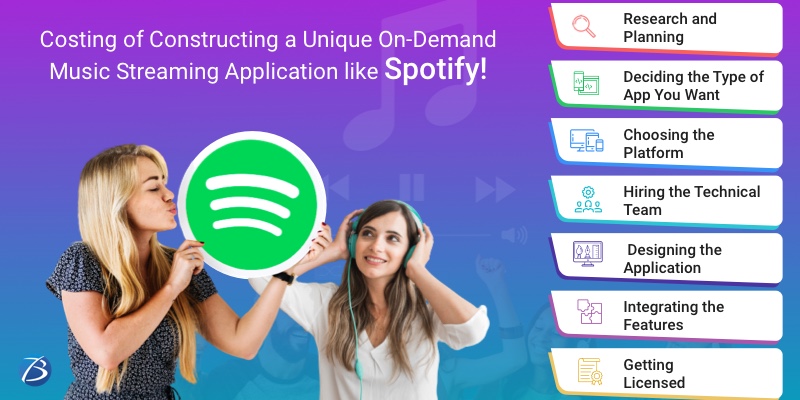
Research, and Planning
Before commencing the development, there is a lot to do. Research on various factors like competitor apps, their USP, your target audience, their age bracket, their likes/dislikes in Music, etc. as all these factors are essential for deciding the app costs. Accordingly, plan the concept of the app that will meet the expectations of your audience.
Deciding the Type of App You Want
There are three categories of On-Demand music applications seen in the market, as mentioned below. You can research and brainstorm with your team to decide on which suits your needs and budget the best.
- Radio Station: In recent years, several radio stations have gone digital for reaching out to a large number of audiences, because today’s audience makes use of their smartphone rather than listening from a separate radio device.
- Cloud Storage: The music streaming applications in this category enable the users to store their favorite audio/video content over the cloud platform itself and listen to it whenever required.
- Server-based Music Library: Such a kind of music app provides a wide range of options to its users. It provides unlimited access to the music of their choice under paid subscriptions or even free options. Users can download the music, and create playlists, based on the subscription.
Choosing the Platform
Platform selection is one of the key factors impacting the development budget. Whether you choose native development or cross-platform, it will affect the cost of app development.
Hiring the Technical Team
Once you have a vision of what your on-demand music streaming app would look like, it is time to search and hire a technical crew for app development. The app costs depend a lot on the country of the tech crew, rates of their developers, etc. Usually, regions like Asia (India, Indonesia, Malaysia), Eastern Europe (Ukraine, Poland, Czech Republic), Latin America (Brazil, Peru, Mexico), and Africa (Nigeria, Egypt, Kenya) are comparatively cost-effective.
Designing the Application
After hiring the team, you need to proceed to make the wireframes for your project. The app design must be highly functional, navigational, and easy to use. For this, it is essential that your development team is well-experienced and knowledgeable.
Adding the Features
Features are vital to any application and they are one of the major factors affecting app costs. Here is a list of the most important features that you must consider in your app:
- Registration
- Profile Creation
- Discovery and Searching the Content
- Music Recommendation
- Social Sharing with Friends
- Online as well as Offline Access of Music
- Push Notifications
- Playlist Creation
- In-app Messages
Getting Licensed
In genuine music streaming application, you cannot simply add anyone’s composition and music just like that. The copyrights and legal procedures must be considered and hence, getting licensed is quintessential. Or else, you will have to face a lawsuit.
For providing your users with high-quality and legal content, you have to get a Public Performance Rights license. This is handled by three agencies in the USA- SESAC.com or ASCAP.com, or BMI.com. Besides this, you will need to share the revenues as royalties to the concerned artists for using their music.
How much does it Cost to Fabricate a Spotify-like App?
We have looked in detail at various cost-forming factors in the aforesaid section. The features to be embedded, the technologies used, design complications, number of OS platforms on which app is to be built, location of the mobile app development partner, etc. affect the costing of the app. So, here is an approximate cost estimation of an advanced music streaming platform:
- An app with basic but essential features i.e. an MVP (Minimum Viable Product) can cost anywhere from $20,000 to $50,000.
- A feature-rich application with advanced features and functionalities would range from $50,000 to $ 80,000 or more.
Final Thoughts
Summing up, we can say that the approximate cost of creating basic on-demand music streaming app like Spotify starts from $20,000, and for a full-fledged feature-packed application, it can reach $80,000 or more. However, just building an app does not guarantee its success. Gaining tremendous popularity like Spotify is not a piece of cake. For creating such a unique app, you first need to have a one-of-a-kind idea. Besides the idea, you need to hire the best app development partner for your project and thoughtfully design the app of your dreams.
So, we hope you enjoyed reading this insightful post.
Also, do you want to know further about the cost considerations of the best music streaming service like Spotify? Connect with us today!

